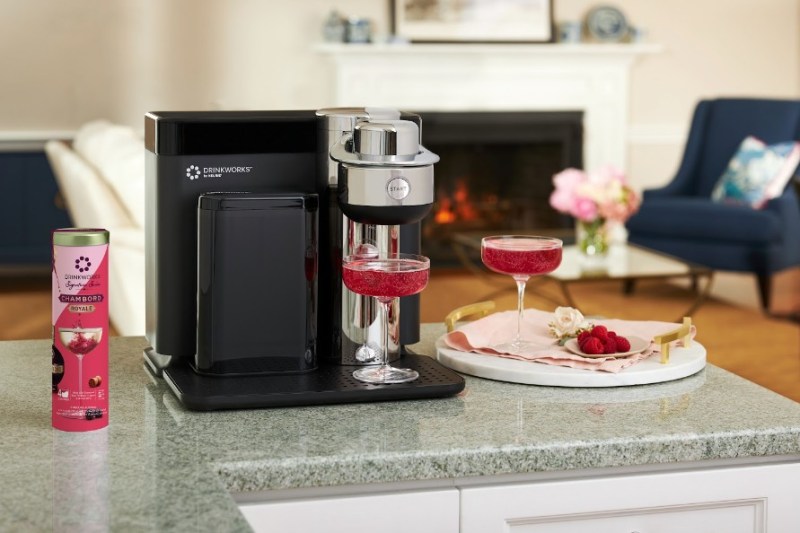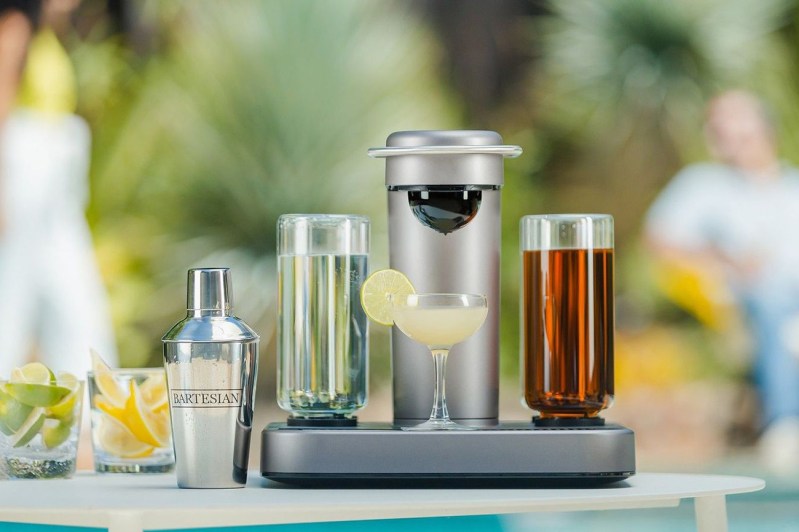Virtual reality bartending? Check. Mechanical fruit harvesters? Yep. Drones surveying and mapping vineyards? Naturally.
The future of the drinks business is already here and it’s evolving exceptionally fast. In many ways, the pandemic is accelerating things, making it easier for you to imbibe at home via takeout cocktails, or engage in virtual tasting. One of the most recent developments is the cocktail pod, a Keurig-friendly hooch capsule that will turn into a mixed drink with the push of a button.
Related Guides
- Essential Cocktail Recipes
- Best Barware
It’s not too hard to imagine. After all, coffee pods are already a mainstay in most hotel rooms and a lot of home kitchens. We live in a world of robot bartenders and waiters, so why not a push-button cocktail engineer? Well, the technology and finished product is there via outfits like Drinkworks, a cocktail machine retailing for a whopping $300, but it didn’t just happen overnight. There are obstacles in mechanizing the experience. Firstly, some drinkers simply like the traditional human-to-human tangibility of sitting at a bar and watching somebody fix a Negroni. But there are more technical issues as well.

Anybody who’s spent time atop a barstool knows the vast array of tools a good barkeep has at their disposal. Shelf upon shelf of spirits and tinctures, trays of ice, bowls of fresh citrus—the list goes on and on. And this is to say nothing of the various tools used to properly put together some of these drinks.
For Drinkworks, one such challenge has been working with ice, a bartender’s trusty sidekick. “Ice is one of the most important ingredients when making a cocktail, whether you’re creating one that’s shaken, stirred, or on the rocks,” says Chandra Richter, VP of Beverage Development at Drinkworks. “Ice not only chills the cocktail, but also influences the aroma and concentration of the drink.”
How Do These Machines Work?
While it’s not quite trending, per se, The Drinkworks contraption is not the only cocktail pod show in town. It follows a lengthy love affair our society has with convenience (just ask the plane-ready cocktail kit) and shiny appliances. Others, like Bartesian, a similar machine that retails for $350, see opportunity in the pod. But $20 for an Amaretto Sour? A Gimlet for $15? You could be drinking a handmade Manhattan in a bar in, well, Manhattan for that kind of cash.
The pod itself is a fairly simple creation, an exercise in ratios. The most popular versions on the market today and concentrated takes on classic drinks, made to be diluted with ice or water or both. That means making high-octane recipes, often with higher-proof spirits, with a minimal amount of liquid.
Pushing the convenience theme a step further, some companies have gone the machine-free route. Bacardi and others have released pods that just require ice and water (and a good shake), allowing you to be your own bartender without looking up a recipe or scrambling for ingredients. In 2019, The Glenlivet turned out a Wonka-esque batch of gelatinous cocktails featuring its whiskey for a trade event. The cocktail pouches turned quite a few heads on the internet.
For those who covet ease, there will always be a place for creations such as these. But after a year essentially without bars, we miss a good barkeep and their creations, not to mention simply sitting next to a stranger and watching a complex drink come to life. Those who’ve sipped a perfect Pisco Sour at an authentic Peruvian restaurant or a expertly crafted tiki drink from a place like Lost Lake know there’ something sacred about a great cocktail. And, perhaps we shouldn’t all be able to just push a button a suddenly have one in hand.
Is This the Future of Bartending?
Drinkworks is the first to admit that the pods aren’t out to replace the bespoke work of bartenders. It’ll be interesting to see what kind of staying power the pod has, with corresponding machine or otherwise. Certainly, we’re seeing more pod-like formats for foods like coffee and olive oil, following the lead of the Nespresso’s of the world.
Presently, though, consumers are somewhat constricted. There are only a few cocktail pod producers and, unless you really hack the system, you’re pretty much forced to make what’s already been made for you (kind of the point, I know, but some people desire more wiggle room). They don’t exist to replace our favorite watering holes but imbibers might want to be a tad more involved. Companies like PicoBrew may have cracked the code, allowing for a bit more flexibility and inviting you to experiment with your own ingredient selections.



